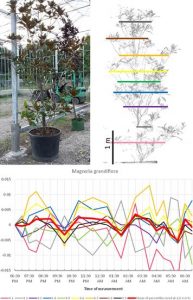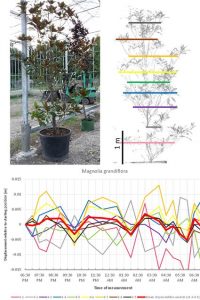By Paul Kieniewicz (SMN)
 Sunflowers follow the movements of the sun. At nightfall some flowers close up their petals. Some legumes also show sleep movements. That some plants move with the circadian cycle is well-known. What about trees? It now appears that certain trees lower and raise their branches, not only at nightfall or sunrise, but also with shorter periods, such as two hours. It’s as if they have an internal heartbeat.
Sunflowers follow the movements of the sun. At nightfall some flowers close up their petals. Some legumes also show sleep movements. That some plants move with the circadian cycle is well-known. What about trees? It now appears that certain trees lower and raise their branches, not only at nightfall or sunrise, but also with shorter periods, such as two hours. It’s as if they have an internal heartbeat.
A study conducted by Puttonen et al (2016) showed that the birch tree, Betula pendula, has a well-defined circadian movement — branches move up to 9 cm downward during the night, and back up at sunrise. The specimens, separated by 2,000 km showed the same behavior, which confirmed that the movements were not related to local influences.
 In a more recent study by Andras Zlinsky et al. (2017) of the Balaton Limnological Institute in Hungary (Publ Frontiers of Plant Science), 22 species of trees were imaged in three dimensions using terrestrial laser scanning (TLS) over a twelve-hour period. The images were processed to determine nocturnal changes in shape. In several trees, branches moved consistently 1 or more centimeters up or down in a regular cycle. Some trees, Acer palmatum, showed a rise of 1.5 cm, peaking at 4.30 am. Magnolia grandiflora’s branches did not follow a diurnal cycle, but instead showed shorter cycles of 2 hours.
In a more recent study by Andras Zlinsky et al. (2017) of the Balaton Limnological Institute in Hungary (Publ Frontiers of Plant Science), 22 species of trees were imaged in three dimensions using terrestrial laser scanning (TLS) over a twelve-hour period. The images were processed to determine nocturnal changes in shape. In several trees, branches moved consistently 1 or more centimeters up or down in a regular cycle. Some trees, Acer palmatum, showed a rise of 1.5 cm, peaking at 4.30 am. Magnolia grandiflora’s branches did not follow a diurnal cycle, but instead showed shorter cycles of 2 hours.
The authors conclude that because ambient light was kept constant during the night, the trees were not responding to any changes in light, but rather were following an internal clock. They write:
Movement patterns recorded can be attributed to in three major types: circadian movement in an 8–12 h cycle (Nerium, Acer, Aesculus, Viburnum, Photinia), periodic movement between 6 and 2 h (Quercus, Magnolia, Pinus, Cedrus), and non-periodic, unidirectional movements (Styphnolobium, Prunus, Gleditschia, Morus). The remaining trees studied (Olea, Betula, Larix, Trachycarpus, Fargesia, Chamaecyparis) either show a combination of these basic movement forms or low-amplitude movements close to the margin of our accuracy or an apparently random pattern.
What are the underlying mechanisms?
That trees absorb water in their roots, emit water from their leaves in a cyclical fashion that correlates with  circadian rhythms, is well-established. Until now it was assumed that the circadian cycle is driven by the sun’s position in the sky. However, for such a cycle to be driven internally, regardless of the sun’s position or of ambient light, is something new. The shorter cycles (2 hours) observed in the Magnolia also need an explanation.
circadian rhythms, is well-established. Until now it was assumed that the circadian cycle is driven by the sun’s position in the sky. However, for such a cycle to be driven internally, regardless of the sun’s position or of ambient light, is something new. The shorter cycles (2 hours) observed in the Magnolia also need an explanation.
Is there an internal pump, analogous to a heart that keeps the trees juices flowing? Are we listening to a heartbeat?
